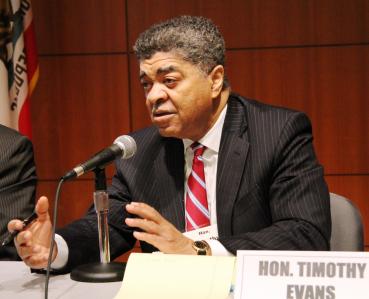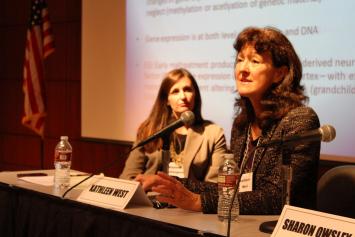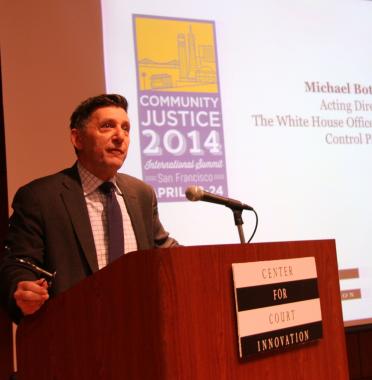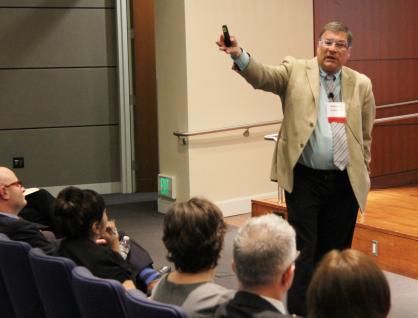In this New Thinking podcast, Tracey
L. Meares, the Walton Hale Hamilton Professor at Yale Law School, outlines the four components of procedural justice and their power
to enhance perceptions of government legitimacy. She also discusses how procedural justice is incorporated into Chicago
Offender Notification Forums, an anti-violence intervention that she helped design. (June 2014)
TRACEY MEARES: Our forums were organized around legitimacy and the idea is this—is that if legitimacy works,
then you’re going to comply with the law because you believe that government has the right to dictate proper
behavior.
ROBERT V. WOLF: Hi, I’m Rob Wolf, director of communications at the Center for
Court Innovation and I am in San Francisco at Community Justice 2014 International Summit, meeting and speaking with
a number of leaders in the field of community justice and criminal justice. Right now, I have the pleasure of speaking
with Tracey Meares, who is a professor at Yale Law School. She is a theorist and a social scientist and I want to
thank you for taking the time to speak with me.
MEARES: Thank you.
WOLF: You
will be speaking this afternoon about procedural justice, which is an issue you have been very involved in and done
research on, and written a lot about. So what is procedural justice? I’ve also hear the word legitimacy as well.
Maybe you can help parse those out.
MEARES: So, I think the way to explain how they fit together
is to start with legitimacy first. And the way I like to explain it is to ask people to think about why they, or
other people, obey the law. Do they obey the law because they fear the consequences of failing to do so? Do they
obey the law because they think it’s the right thing to do? Do they obey the law because they think government
has the right to dictate to them proper behavior? The concept of legitimacy encompasses the last idea, that is people
complying voluntarily because they think government has the right to tell them what to do. And it’s a very powerful
when you think about it because unlike the first one—I’m obeying because I fear the consequences of failing to do
so—that’s only gonna work if people perceive there to be someone to carry out a threat. That’s deterrence,
right? That’s often the way criminal justice systems are organized. The second idea, that you’ll obey because
you think it’s the right thing to do, that’s morality. You know, people think about inculcating that idea
through religion and other things, what you teach your children. And that’s a really, really powerful way to
get people—that’s probably the most powerful, that people mostly obey the law because they think it’s the
right thing to do. But every once in awhile there are gonna be laws that you actually don’t think are the right
thing to do. I think historically—registering for the draft, or drug laws, or certain things.
And why is it that people obey those laws? Often it’s because they think that government has the right to dictate
to them proper behavior. And so where does procedural justice fit in? Well, social science research has shown that
procedural justice supports this idea that people will obey because they think government has the right to dictate
to them proper behavior, legitimacy. Procedural justices are the components of government behavior that people tend
to focus on when evaluating legal authorities and finding them fair. There are four factors that people really focus
on. One factor is voice, a second is decision-making neutrality, a third is respectful treatment, and then a fourth
is trust and benevolence. And I’ll explain all four of them in greater detail. So by voice I mean people like
to have an opportunity to tell their side of the story. In a court context, people like to say, well this is what
happened to me. And it’s very important that they have a chance to tell their side of the story, even when it
turns out that it has no impact at all on the outcome. Second, decision-making neutrality. People look for, in interactions
with legal authorities, and they look for indications that the decision that that person is making is neutral and
fair. And one of the best indications is that the person in legal authority gives a reason for what they’re
doing. So the violence reduction strategies that I’ve been involved in, we bring people together who have violent
crimes or gun offenses in their history and, you know, we explain to them the consequences of their behavior, and
we provide them an example of someone who’s changed their life around. And we offer them services. And we say
look, going forward, if you have a gun these are going to be the consequences for you. The reason why that’s
important is so that if that happens, or when that happens, they’ll know exactly why it’s happening and
they’re not singled out because they’re from—well I’m in San Francisco now—they’re
from the tenderloin, or because they’re African-American, or because they’re a young Latino, you know?
They have been given a reason and they know what the reason is. The third factor that’s really, really important
for people is treatment with dignity and respect. And that has often been translated in some other contexts by people
who don’t really understand the theory as just being nice. Like basically you can do whatever you want to people
as long as you’re nice. And I think that it is true that it is possible for police to violate constitutional
dictates and treat people with respect, and have people be relatively satisfied with the encounter after. But you
know, over time obviously that will run into the other factors that I was talking about, clearly. But treatment with
dignity and respect is really key, and research shows that different ethnic groups and racial groups care about these
factors to a greater extent. So Latinos, in particular, really care about this factor.
WOLF: Before
you go on, you mentioned, research has shown. Has it shown for the treating people with dignity and respect produces
a more positive feeling from the litigant or the defender, whoever’s detained, is that true also, has research
of all these aspects of procedural justice voice, decision neutrality—I know you’re going to go on to speak
about trust—have they been all researched in similarly rigorous ways?
MEARES: Yes. Well, because
when you look at the, when you look at the research on procedural justice it’s not as if the research singles
out each individual factor. It’s the bundle of the factors that go together and most of this is done through
survey work, and you can ask people particular questions, and we create scales that capture the different aspects.
And so the last aspect is the one that’s the most amorphous, but basically it’s a more general category
that tries to capture the idea that a person expects to be treated benevolently in the future by the person in legal
authority.
WOLF: Well that’s very interesting. Thank you for the primer on procedural justice
and what it is, and the four components that define it. Let’s talk a little bit about the violence reduction
strategies that you referred to, you were associated with the Chicago forums of the Project Safe Neighborhoods Initiative,
federal initiative, and I know that those are adaptations or related to what are sometimes referred to as call-ins.
There are different names for them that David Kennedy and others developed in Boston, I know in High Point North
Carolina as well. So maybe you could tell me a little bit about the Chicago model, how they work and what is different
about what was developed in Chicago.
MEARES: Well we owe, obviously, a huge debt to the work in
Boston that David and his colleagues have done. That work focused on groups of kids, youth, reciprocating in violence
because of beefs. And so they map that out and they talk to them about the consequences of being involved in violence,
and—
WOLF: And this was really murders and gang violence, right?
MEARES: Yeah. So the first thing we did was structural because mapping that out takes a long time, and we
didn’t have the time or the resources to do it when we started. So we decided to use an individual level intervention,
rather than a group-based intervention. And we selected people based on their criminal history status. So in order
to attend a Chicago forum, you had to have a gun crime in your history or a violent crime. So basically as you got
out of prison, we called people in in groups of 20. And we would have call-ins every three weeks.
WOLF:
Did they follow a similar model where you had people who are giving both a positive message and a message of, if
you—here are resources for you to get your life on track, and here are the consequences
if you don’t, and they could be very serious consequences.
MEARES: So, we were definitely
inspired by that model. Our forums were organized around legitimacy, and the idea was this —is
that if legitimacy works then you’re going to comply with the law because you believe that government has the
right to dictate to you proper behavior. And if it doesn’t then, you know, we have deterrents and we have these
other things, but our overall goal was that. And so the design of the people who were speaking, where we had it,
the structure of the room, everything was all about enhancing legitimacy. So there’s a law enforcement message,
a key part of that law enforcement message is the local police commander saying to the participants, I am your police
chief. It is my job to keep everybody in our community safe. You’re a part of this community and it is my job
to keep you safe. So right there it’s an identification of the participants of members of the community with
value. The ex-offender who tells the story about changing his or her life is really important. I tell that person
to say that this is really hard work. And the service providers are there too, to provide information about an option
because the key to legitimacy is activation of agency, right? It’s internalized. So the constant message is,
this is up to you. No one can make you do it. I’m not gonna make you do it. All I’m gonna do is give you information
about the consequences, but this choice is yours. And then finally architecturally we set up the room in a very particular
way to signal that we’re all in this together. And the tables are in a circle like this, and there’s no
podium.
WOLF: Right, so there’s no podium and not an audience all facing one way. It’s
a circle.
MEARES: It’s a circle and that’s really important. And I also, I never have
the forums in law enforcement location. So we have them in places of what we call civic importance. So in New York
we have it in the Adam Clayton Powell building, and in the Bronx they have it in a beautiful museum, and in Brownsville
they have it in the library. And these are places that citizens go to and, you know, these are folks who should be
welcome there too. And that’s also part of the signal.
WOLF: Well thank you very much. It’s
been very interesting and I really appreciate your taking the time to speak with me. I’ve been talking with
Tracy Meares, who is a law professor at Yale Law School. She’s a social scientist and she is an expert on legitimacy
and procedural justice, so thank you so much.
MEARES: You’re welcome. I had fun.
WOLF: I’m Rob Wolf, director of communications at the Center for Court Innovation. To listen to more
podcasts and to learn more about procedural justice and community justice you can visit our website at www.courtinnovation.org.
Thank you for listening.
Podcast: Play in new window | Download



